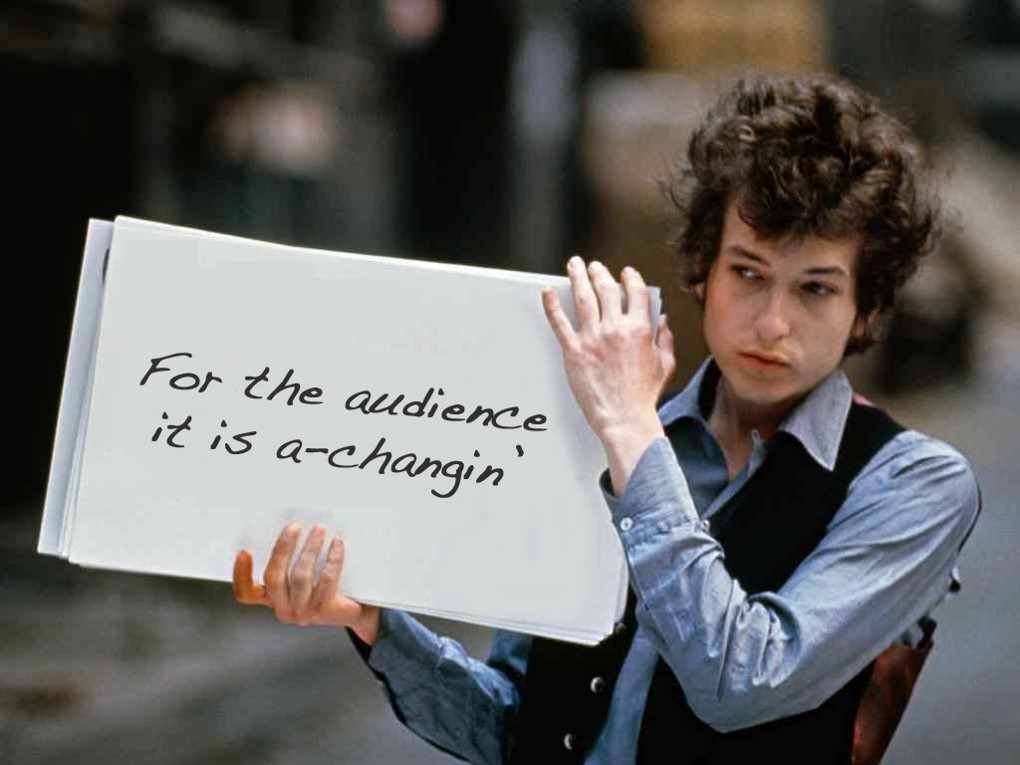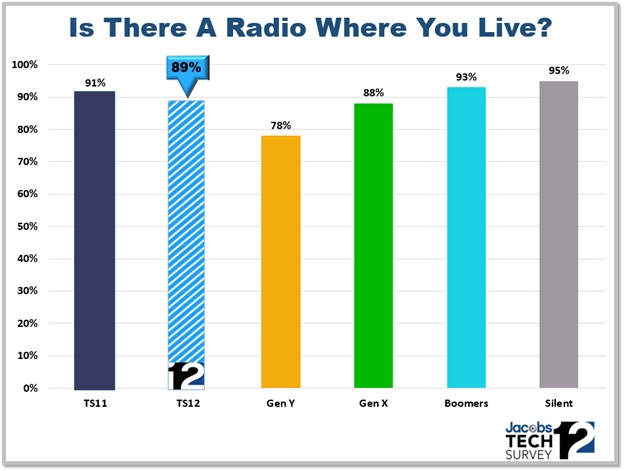
For me, research has always been the light switch that stimulates thought, questions, and ideas. And the study from Forrester we included in a post last week about “the selfie culture,” continues to boomerang in my brain. “The Rise Of The Empowered Customer” is a paint-by-numbers guide to the changing culture of consumers, especially important for those of us toiling away in a traditional medium like radio broadcasting.
As I continue to consider that study’s highlights from the Center For Media Research’s “Research Brief,” the takeaways point the way to a deeper understanding of the major media shifts that have been taking place, and will continue to take root over time.
Yes, much of this movement starts with young people and snakes its way to older generations. The Bob Dylan pictured above is just 24 years-old – yes, the equivalent of a Millennial back in 1965 when the original photo was taken. Of course, he was then a member of a Baby Boomer generation that was undergoing similar seismic culture changes.
So thinking about some of Forrester’s conclusions, in light of an industry that must change in order to survive and thrive is where my thought process is headed. Consider…
The willingness to experiment
Forrester suggests that rapid disruption means that consumers will try new things at an even faster pace than before. For the consumer electronics industry, this trend has been their lifeblood. But of course, it cuts both ways. An openness to trying new innovations or gadgets also means gravitating away from tradition in order to experience something new.
For an industry that’s nimble, willing to launch a new show, a new app, a new video series, or a new podcast, the door has never been more open. Add that to radio’s ability to get the word out, and you have a fertile environment in which to try new things.
Big market radio has experienced the chilling effect of PPM, impacting everything from playing new music to programming creative weekend feature programming. Moving in the opposite direction is the digital arena – websites, podcasts, mobile, and social – the places where consumers are moving to discover new things.
Radio needs to show some cutting edge thinking and take some risks, and the digital sandbox is that safe haven for experimentation, where failure is excusable, but the same-old-same-old is not. There’s very little cost – aside from time – for launching new concepts in a space where it’s expected and for consumers who increasingly welcome them.
Device usage
The research shows there are more gadgets on this planet than people. Forrester reports than in just a two-year period (2013-15), the percentage of Americans that own a personal computer, tablet, and smartphone has skyrocketed from 6% to 37%.
If that doesn’t shake up the tower-transmitter conversation, nothing will. Because the converse is that traditional radios are disappearing in homes throughout America. We continue to track ownership of a working AM/FM radio at home in our Techsurveys, something we first picked up on in “The Bedroom Project” way back in 2007 where many of our young respondents didn’t own a radio in their apartments and dorms.
In this year’s TS12, the percentage of traditional radios on the homefront continues to drop, especially among the Millennial set:
 It has never been more essential that broadcasters make content available on any and every platform the audience uses – and will use moving forward. Mobile is obviously the nexus of that conversation. And it’s one of the key reasons why our jācapps team is moving full speed ahead on its AppEverywhere℠ initiative, ensuring radio mobile apps aren’t just available on smartphones, but on smartwatches, tablets, smart TVs, dashboards, and other gadgetry that becomes a part of consumers’ media arsenals.
It has never been more essential that broadcasters make content available on any and every platform the audience uses – and will use moving forward. Mobile is obviously the nexus of that conversation. And it’s one of the key reasons why our jācapps team is moving full speed ahead on its AppEverywhere℠ initiative, ensuring radio mobile apps aren’t just available on smartphones, but on smartwatches, tablets, smart TVs, dashboards, and other gadgetry that becomes a part of consumers’ media arsenals.
Broadcasters can no longer hope the ubiquity of AM/FM radios will be the difference maker. In the world described by Forrester, new gadgets are proliferating, replacing those traditional radios at home, work, and yes, in cars. Broadcasters need to accept that fact, and be on whatever devices the audience adopts.
Information savviness
“The Empowered Customer” notes that the average adult consumes five times more content than she did three decades ago. That’s mind-blowing, and it suggests that much of the information radio broadcasts is already known and perhaps unnecessary.
Thus, incessant time checks, “The Concert Calendar,” traffic reports, and other pieces of info in which radio once excelled are becoming superfluous and perhaps even irritating.
What is it consumers need to know in a landscape where Google Now, Alexa, and Siri answer all questions and queries in a digital eyelash? Thinking about the facts, info bytes, and other nuggets the audience already knows opens the door to providing content they can’t get anywhere else. Yes, it raises the content bar, but it also forces programmers and talent to rethink the givens.
This could be a key reason why storytelling not only hasn’t gone out of style, but perhaps resonates more deeply in an environment where the audience seemingly knows “everything,” and thus, a great story with a surprise or two can go viral and contribute to the value of a local brand or a hometown personality.
And it also engenders a spirit of creating experiences for listeners they simply cannot get anywhere else. This may be a key component in why festivals and events continue to draw big crowds. The electric charge of “being there” and seeing a hot new band or a beloved personality in the flesh trumps Facebook Live.
It also means music radio programmers and talent need to work harder to provide information and entertainment in an age when the audience has heard new music even before it’s delivered to the station. What is that radio can do they simply can’t get anywhere else in the way of backstage experiences or other opportunities consumers cannot get online?
Research like Forrester’s “The Rise Of The Empowered Consumer” adds that behavioral component to a radio research regimen that too often focuses on the basics of ranking music preferences, song fatigue levels, and DJ recognition scores, glossing over the tectonic shifts that are happening right here and right now. We need to ask the right questions to better determine the information and entertainment elements that radio can bring to speakers and ear buds they can’t get anywhere else. Instead of looking at digital as a speed bump that disrupts the radio industry, viewing it as an avenue that paves the way to risk-taking, more access pathways, and new content outlets is the way to ensure the medium’s relevance.
Dylan had it right all along.
- What To Do If Your Radio Station Goes Through A Midlife Crisis - April 25, 2025
- A 2020 Lesson?It Could All Be Gone In A Flash - April 24, 2025
- How AI Can Give Radio Personalities More…PERSONALITY - April 23, 2025




It must be a difficult balancing act with one set of data and research saying to tighten playlists, and limiting the song rotation of a station to 600-800 songs and sticking with the “tried and true” while other research and data is saying that audience is slipping away to content providers other than traditional radio because this part of the audience feels radio is not serving their preferences.
Mr. Jacobs, or anyone, care to comment on whether you think we will see a tipping point where greater variety and deeper catalogue may win out?
Kurt, you’re right that radio is playing two games at the same time, and “the rules” are very different in each. As long as radio remains primarily focused on “radio dollars,” tight playlists will continue to be the norm especially in larger markets. But as you correctly point out, in the digital world, sensibilities are different. For now, radio risk and innovation is very likely going to be confined to digital outlets. And the hope is that the industry steps up and begins to innovate there – podcasts, streams, apps, etc. Thanks for the comment and the thought. (And by the way, 600-800 titles is more like double the norm these days.)
Hi Fred,
A digression, but as you’ve mirrored BOB DYLAN as 1965’s “equivalent millennial” for a “shifting culture” this piece from AUDIE CORNISH’S “All Things Considered” last year, on the 50th anniversary of Dylan’s “Highway 61”, and what TODAY’S millennials think of Dylan and the album is a salient listen.
https://www.npr.org/2015/08/28/435577938/a-new-ride-down-dylans-highway-what-do-millennials-think-of-the-album
It perhaps points to opportunities radio can capitalize on in new ways across today’s platform array IF it bothers to inject itself into the center of the conversation, rather than seeing itself as separate and outside it, and pontificating and philosophizing, around an audience “shift” that has been happening for well over a decade.
Lee, thanks for weighing in. As you note, these shifts have been in play for a long time now. Radio has been slow to pick up on them.
The NPR piece is excellent (I love the line about “singing the story”).
Thanks, Lee.
With the moves made by CBS and Greater Media, it seems that there is a rush to get out, based on someone’s metrics. Still, for those in the game, Fred, you make excellent points about what content sticks and what is a waste of time, or even irritating. Maybe the answer is to start hiring young guns to reinvent the media, and let them guide the way to relevance in the new age. But they will have to reconcile a tough reality: there is no long line of youth dying to be in the radio biz. They’ll have to fight for the right – to party!
Tai, it IS a tougher environment out there, but I continue to be impressed with how many young people still want to work in radio. It’s gratifying and heartening – something I felt at the Morning Show Boot Camp a couple weeks back. They are, of course, the future is they’re given the chance to carve it out.
And regarding radio companies rushing to get out, remember they are selling their stations to somebody. The fact that Entercom, Alpha, Hubbard, and several others are still buyers says something about the value of the business. It is NOT what it used to be, but it still can be a great way to make a living and a contribution. Thanks for taking the time.
Conventions are a great way to catch up and express enthusiasm for your craft/industry. Frankly, I am envious – wish I could have attended, as I did morning drive for a total of 13 years. Here in Boston we have two syndicated morning shows on major radio stations. This would have been unheard of, even a few years ago. A CBS insider recently told me point blank: if the IPO goes poorly, expect massive layoffs. Also, the Greater Media sale was so drastically out of whack with the math (maybe you heard Howard on the subject)that one has to come to the conclusion that even first rate private and public companies cannot embrace corporate radio any longer. It’s got to return to local content and control, and I hope I live to hear it.
Tai, there are many who believe that radio’s salvation in this new media landscape will be a re-dedication to its local ethos. How that takes shape is anyone’s guess, but there will be more shaking up ahead. Thanks for the comment.